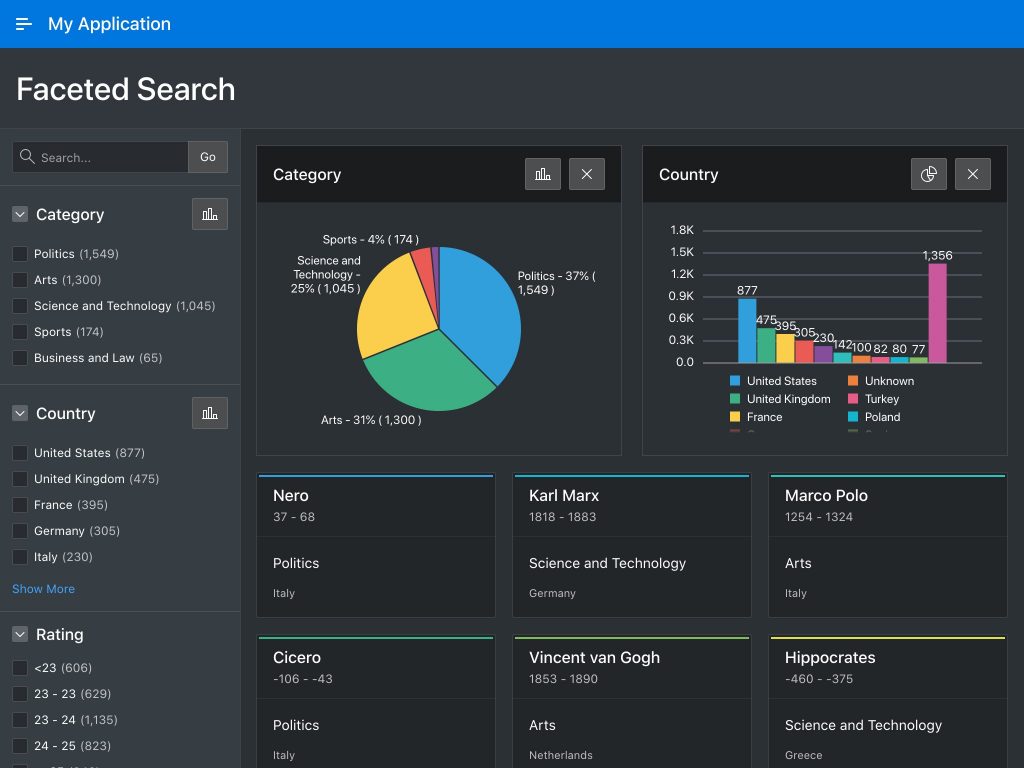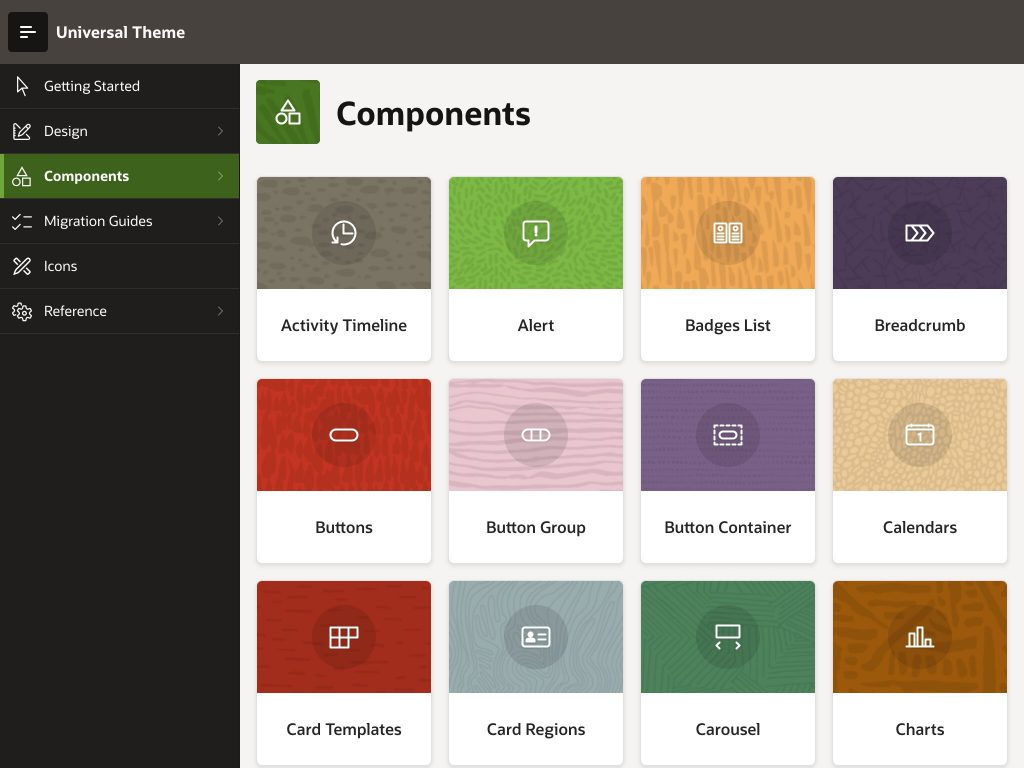Original Post by Joel Kallman
Oracle Application Express (APEX) 20.2 is now generally available!
Oracle APEX is the world’s most popular low-code platform for enterprise apps and enables you to build scalable, secure enterprise apps, with world-class features, that can be deployed anywhere.
This release of APEX introduces several new features and enhancements to help developers be more productive than ever before. From the all new Cards component, Automations, and REST Data Synchronization, to charts in Faceted Search, REST Connector Plug-ins, Report Printing improvements, Redwood Light Theme Style, and an exceptional code editing experience across all of App Builder, APEX 20.2 an epic release that has something for everyone. Here are some of the feature highlights:
All New Cards Component
The new Cards component unlocks a powerful new way to present data and provides developers with the ultimate control and flexibility over the user interface.
The Cards region provides easy customization of nearly every aspect of the card UI, including the layout, appearance, icon, badge, media, advanced HTML expressions that support client-side templating, and for the first time, the ability to define multiple actions per card. This means that you can include any number of actions, such as links or buttons, on a single card, all without writing a single line of code.
You can visit the Cards page on the Universal Theme Sample App to see them in action. You can also visit the Sample Cards application to see advanced usage of the new Cards component.

Automations
Automations are a conditional set of actions that are automatically triggered by changes that occur within database tables or remote data sources. They are used to monitor data and then perform the appropriate action (examples are auto-approving specific requests and sending email alerts). An automation can be triggered on Schedule or on Demand, by invoking the APEX_AUTOMATION API.

Faceted Search Enhancements
- Bar or pie charts of facet value counts
Quickly display a chart of facet value counts in a dialog or ‘dashboard’ area. - Groups of checkbox facets for Boolean columns
Checking the facet will find records that match the ‘yes’ or ‘true’ value of the column. - Input Field facet type
Input Field facet type supports comparing a user-entered value with the facet column. This enables faceted searches such as finding stores within a user entered number of miles or records where a column contains the user entered text. - Performance optimization for distinct value facets

Report Printing
- Built-in PDF printing and Excel download
Built-in APIs to print PDF and download Excel in interactive reports and classic reports. - Interactive Report – Send E-Mail
All download formats can now be attached. - Enhanced integration with Oracle BI Publisher
- New APIs to generate files
Introduced new APEX_REGION.EXPORT_DATA and APEX_DATA_EXPORT APIs to programmatically generate PDF, CSV, Excel, HTML, JSON and XML files. - More language support
Built-in PDF now supports Chinese, Japanese and Korean languages.

REST Data Source Synchronization
- More control over REST Source Data
REST Source Data can be appended or merged to the local table. Replacing all local data is also supported. - Local or REST Source Data
APEX components using the REST Data Source can be configured to use the local table instead. - Configure Technical Details
Technical details like HTTP request limits, commit intervals or delete methods for the Replace mode are configurable. - Automatic Table Generation

REST Data Source Connector Plug-Ins
- REST Service Handling
The Plug-In code handles REST service-specific implementation details like the pagination style or how filters are passed to the REST API - Automatically Pass Relevant Information
When APEX invokes a REST Data Source (e.g. to render a report), the engine will invoke the Plug-In code and pass all relevant context information. - HTTP Requests
The Plug-In code executes one or multiple HTTP requests and passes results back to the APEX engine. - Automatic Processing
APEX processes the REST response received from the Plug-In.
New Web Credential Types

Redwood Light Theme Style

Developer Experience
- Multiple Tabs in Property Editor
Page Designer has been enhanced to support multiple tabs in the Property Editor pane, making it more efficient to access the attributes of a region. - Monaco Editor
Oracle APEX now uses Monaco Editor to provide a vastly improved coding experience throughout the development environment. The new editor provides in-context code completion, syntax highlighting, and superior accessibility. - Inspect the SQL, PL/SQL and JavaScript code with Ease
The Embedded Code utility allows developers to inspect the SQL, PL/SQL and JavaScript contained within an APEX application. Having the ability to view the embedded code makes conducting tasks such as code reviews, security evaluations or application tuning, far more convenient. Code can be saved to the file system from the App Builder, or using the APEXExport utility. - Quick SQL Enhancements
Quick SQL now enables you to save and load data models, provides automatic primary key column defaults, and delivers far better coding experience with improved syntax highlighting and autocompletion for table and column directives.

New and Improved Items
- New Checkbox
This single checkbox offers an alternative to the Switch item type for Boolean columns. This works in Interactive Grid as well, even when not in edit mode. The previous Checkbox type has been renamed to Checkbox Group. - File Browse
File Browse item type has been enhanced to support rendering as a drop zone, supporting the drag & drop of a file to be uploaded. - Rich Text Editor
Rich Text Editor item type has been upgraded to use CKEditor 5 and now supports markdown output. - Text Field
Field item type has a new Text Case setting to optionally transform the user-entered text to upper or lower case. The Text Field Trim Spaces and Text Case settings and Textarea Trim Spaces settings are now applied on the client as well as the server.
Additional Features
- Tree Region Enhancements
Tree region type has been enhanced to support lazy loading and refresh without having to reload the full page. - New Interactive Grid Saved Report Static ID Support
Linking to Interactive Grid saved reports should use the saved report static ID instead of the report name. With APEX 20.2, the APEX_IG API has been updated to require using the saved report static ID rather than the report name, when linking to Interactive Grids. - Web Source Modules are now named REST Data Sources
As in every APEX release, a number of enhancements and bugs fixes have been made to the productivity and sample applications. Additionally, numerous bugs have been fixed in APEX 20.2, resulting in even higher quality and stability for APEX environments.
For more information about many of the other exciting new features in APEX 20.2, please see the Release Notes or visit the What’s New page.
Recent Posts
- 20 Oracle APEX Interview Questions and Answers September 13, 2023
- Download BLOB From Database in Oracle APEX November 12, 2020
- What’s New in Oracle APEX 20.2 October 29, 2020
- Interactive Report Custom Search With Cell Highlight July 23, 2020
- Oracle Ramps Up Free Online Learning and Certifications for Oracle Cloud Infrastructure and Oracle Autonomous Database April 1, 2020
- Tabular Form Insert Data Using Loop March 30, 2020
- Oracle Apex Social Sign In with Google / Gmail March 28, 2020
- Learn how to resolve Image loading / Environment issue in Oracle Apex March 24, 2020
- What’s New in Oracle APEX 20.1 March 22, 2020
- Classic Report Column Total March 19, 2020
